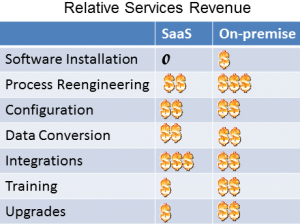Services in a SaaS environment
 SaaS customers are paying their vendors to provide the complete Software as a Service while eliminating much of their own IT overhead. Since the SaaS vendor is providing the IT services for their product to the customer, the SaaS vendor assumes responsibility for the “DevOps” for the SaaS product. These services are included in the MRR so this is a cost area for the SaaS vendor with no incremental services revenue. The SaaS Professional Services provided by the SaaS vendor or their partners is directed at providing direct business value, not performing installations, custom code modifications, maintenance, and installing upgrades. Services are shifted from low value tasks to higher value business specific functions.
SaaS customers are paying their vendors to provide the complete Software as a Service while eliminating much of their own IT overhead. Since the SaaS vendor is providing the IT services for their product to the customer, the SaaS vendor assumes responsibility for the “DevOps” for the SaaS product. These services are included in the MRR so this is a cost area for the SaaS vendor with no incremental services revenue. The SaaS Professional Services provided by the SaaS vendor or their partners is directed at providing direct business value, not performing installations, custom code modifications, maintenance, and installing upgrades. Services are shifted from low value tasks to higher value business specific functions.
SaaS requires fewer Services overall
The ratio of Services to SaaS revenue for SaaS vendors is much less than for on-premise for the duration of the deployment. While reducing some lower customer value Professional Services revenue for vendors and their partners, it enables a shift to more strategic services.
True SaaS platforms share the code between tenants, so there is no cost (or opportunity) to have unique code for a customer within the software system. Upgrade Services are nearly eliminated, but in complex SaaS systems, there may be be some planning and project management to ensure that any necessary configuration, integration, or user experience changes for new releases are made with minimum end-user impact.
SaaS configuration costs are similar or lower than on-premise costs
Configuration costs are comparable, but SaaS software may have more out-of-the box configuration options giving the customer more control. Generally more of the SaaS configuration options are accessible through customer “self-service” potentially reducing the software vendor or partner configuration services.
SaaS Integrations can be more complex
SaaS integration capabilities have matured substantially in the last several years, but SaaS integrations can be more difficult than on-premise integrations. SaaS integrations must be done through vendor provided APIs since it is not possible to directly access the data as in an on-premise server since the data on the SaaS system running in the cloud is not directly accessible by the IT organization. SaaS vendors are rapidly expanding the scope and completeness of their APIs, and new integration tools like Dell’s Boomi and IBM’s Cast Iron facilitate the integration process. Some SaaS offerings are providing “apps stores” like functionality providing standard integrations with a popular set of products. The promise of SOA (Service Oriented Architectures) for more comprehensive integrations with other applications is coming to SaaS, but standard integrations are far from being universally available.
SaaS products generally support more online training tools
Since SaaS deployment generally start out smaller than on-premise applications, online, customer directed training is more prevalent. Users can get the training they want, when they need it without waiting for a vendor or partner training.
SaaS projects often include Analytics or Mobile deployments requiring new Services
While the total SaaS Services may be less than on-premise, SaaS helps enable other major IT projects, particularly Analytics and Mobile capabilities requiring additional Services and revenue potential for SaaS vendors and their partners.
Cloud Strategies will work with your team to ensure your Services strategy is best-in-class for SaaS companies providing superior customer satisfaction and a profitable revenue stream.

